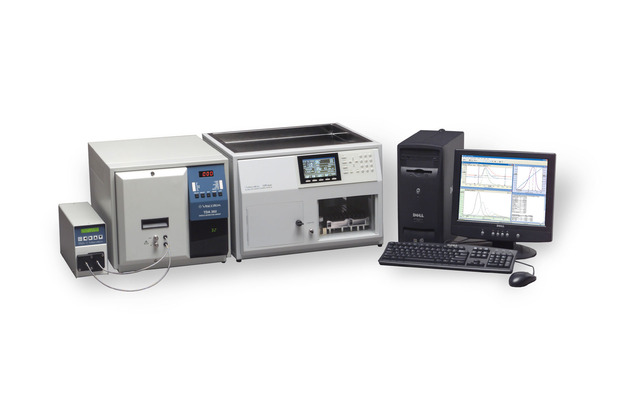Detective work
27 Feb 2013
Stephen Ball from Malvern Instruments discusses the potential of different detectors to boost productivity in gel permeation chromatography.
Gel permeation chromatography or size exclusion chromatography (GPC/SEC) is a central analytical technique for the analysis of polymers, macromolecules and proteins.
It can be thought of as an analysis of two halves. The first step involves size fractionation of a dissolved sample using a column containing a microporous packing material with appropriate characteristics. The second is analysis of the resulting sized fractions, as they elute, using appropriate detectors.
Because of the two-stage nature of the analysis, there is a considerable amount of choice when selecting an appropriate system. While there are some advantages to a fully integrated, singly sourced solution, I would argue that these are secondary when compared with the benefits of getting the best detector array.
Optimising detector choice is both straightforward and productive, and creates systems that, for example, determine absolute molecular weight, hydrodynamic size and structural characteristics in a single experiment.
This begs the question: How can I identify the best detector array for my application? This is a broad topic but a good starting point is to gain a basic understanding of what different detectors have to offer.
Complexity arises because of the different detectors designs available
Starting first with a viscometer, this measures a range of viscosity parameters, which for polymeric solutions tend to correlate with the molecular weight of the sample. In tandem with an RI detector, a viscometer enables universal calibration, removing the requirement for system calibration with a standard closely similar to the sample being tested, and at the same time enhancing the integrity of molecular weight distribution data.
If, however, molecular weight is being measured using an alternative detector then viscosity measurements enable the determination of structural information, quantifying, for example, polymer branching.
This brings us on to static light scattering detectors, which directly measure absolute molecular weight. Here complexity arises because of the different detectors designs available: LALS, RALS, and MALS. All these detectors determine molecular weight via measurement of the intensity of scattered light, but in each case the angle at which that intensity is detected differs: Low angle light scattering (LALS, detection at 7o to the incident ray), right angle light scattering (RALS, detection at 90o to the incident ray) and multi-angle light scattering (MALS).
A key point to understand is why they have evolved. For larger molecules, (>12nm) the intensity of scattered light produced varies as a function of angle to the incident ray. The maths of molecular weight determination depend on knowing scattering intensity at 0o to the incident ray, where it can’t be measured, so for these larger molecules alternative solutions have been developed.
Overlaying this technical discussion are industry trends and preferences so, for example, SEC-MALS has become a standard in protein characterisation where, on the basis of molecular size RALS could be argued as being the better choice.
Dynamic light scattering (DLS) extends the list of light scattering detector options. DLS is a technique widely applied for particle sizing in the nanometer range and, most usefully for certain users of GPC/SEC, protein analysts being a prime example, it accurately measures hydrodynamic molecular radius. DLS detectors, also have static light scattering capability and may therefore supply molecular weight measurement.
Because of the two-stage nature of the analysis, there is a considerable amount of choice when selecting an appropriate system
Last but not least, there are detectors based on UV technology to choose from, both single and multiple wavelength options. A single wavelength UV detector may be a more precise alternative to RI concentration measurement, for samples containing a chromaphore, but in combination with an RI can determine the proportion of a specific component within each eluting size fraction.
This can be extremely valuable for assessing, for example, monomer concentration as a function of molecular weight for a copolymer. The ability to measure a multiple wavelengths extends greater flexibility and capability.
I believe there are two points which I feel are critical in optimising its application. Firstly, it is vital to recognise how advances in detector technology have transformed the potential value of GPC/SEC. And secondly to choose a detector array that is really going to work for you and your application it’s crucial to access some technical understanding and apply a logical approach.
Getting this aspect of GPC/SEC right is the key to long-term productivity and cost-efficient information gathering.
Bio
Stephen Ball, product marketing manager at Malvern Instruments
Stephen holds a degree in Computer Aided Chemistry from the University of Surrey, UK, which included a year in industry working as a research chemist for the Dow Chemical Company in Horgen, Switzerland. Before joining Malvern Instruments, he worked for Polymer Laboratories as an applications chemist, then took on a marketing position as a product manager for light scattering instrumentation at Agilent Technologies.





